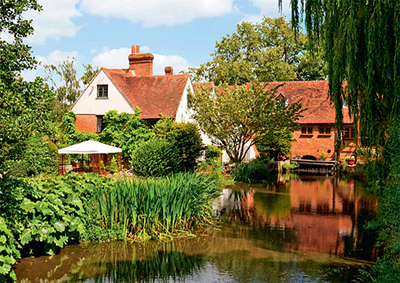How to insulate your period house
Proper insulation is a crucial ingredient of all Green energy measures. Pippa Cuckson explores the best options for period houses


Government research recently claimed that energy efficient homes sell for 14% more than unimproved properties. The 325,000 houses surveyed for the Department of Energy and Climate Change (DECC) had an average floor space of 1,022sq ft, so those figures are easy to dismiss in the context of country houses, whose size and attractive features will eclipse buyer concerns about draughts and double-interlined curtains. Nonetheless, DECC research flags up the lamentable energy-efficient rating of older properties. Half of the houses built before 1929, irrespective of size, have Energy Performance Certificate (EPC) ratings of E or worse (G is the lowest), compared with just 3% of those built since 1996.
However, many older properties can achieve a saving on the fossil fuels they already use by introducing basic insulation. As Tarquin Henderson, director of Reenergise Renewables, explains: ‘Energy generation is terribly sexy- shiny solar panels, lots of clever wires and pipes. It's not the same as energy efficiency, which tends to be hidden.'
Concealed insulation is also overlooked when selling a property, says independent country house-finder Colin Mackenzie. EPC assessors sometimes don't ask about it because ‘the need to see documentary proof implies remaining at the property far too long'.
There are many measures that can be introduced at reasonable cost. Loft insulation is still a simple DIY task where the space is straightforward, or you can call in specialists such as the London Insulation Company, which recently insulated a complex 861sq ft loft in a barn conversion for £3,800, including a new floor and supporting joist.
Any house built before the 1920s will have solid (rather than cavity) walls, usually detectable by the short end appearing in brick patterns. Solid-wall insulation, which must meet building regulations and a set U-value (a figure that indicates how quickly heat passes through), reduces condensation as well as saving heat, 45% of which escapes through solid walls. Both external and internal insulation is undesirable (or unachievable) where there are period features, but the former can be unobtrusively installed under hung tiles, or when roofs are replaced and sections re-tiled.
When looking at insulating a solid wall internally, you have a choice of two main methods: using rigid prefabricated boards or attaching a timber or metal studwork frame to the wall and filling with insulation before plastering. This costs thousands of pounds and is a professional job. Owners of small cottages should also consider the impact of internal insulation on room size, as it can be 10mm (a third of an inch) thick. Although frustrating to hang, a thinner DIY wall veneer by Noma Therm, over which you can paper, has garnered good reviews.
Heat escapes rapidly through windows, too. Double glazing remains a problem in listed buildings, but is no longer a non-starter for sash or leaded windows. Both big-name and local suppliers nowadays faithfully match authentic styles. New frames-as well as glazing-will have insulation properties significantly superior to wood.
Sign up for the Country Life Newsletter
Exquisite houses, the beauty of Nature, and how to get the most from your life, straight to your inbox.
If neither double nor secondary glazing appeal, at least consider replacing original glass, which will be extremely thin. And remember that old frames can warp, letting in cold air. Specialists can remove sashes and fit them with recessed brush strips, as well as replacing putty. DIY draught strips are simple to fit on other timber-framed windows and doors. If your house is on mains gas, it's also worth investing in an A-rated high-efficiency condensing boiler, which recovers heat otherwise wasted from the flue.
Existing central-heating systems can be revolutionised by having radiators professionally flushed (about £350 per dozen). Consider replacing old-style seam-top, single-pressed panel radiators with modern fin-types, giving a greater surface area/heat output. The historic practice of mounting them under windows is misplaced. If you can't re-site them, insert reflective panels behind radiators on external walls. Adopt the zoning habit to avoid heating rooms or wings in irregular use.
New systems can computer-control this; at the most basic level, thermostatic valves are inexpensive to install on original radiators and enable you to zone manually. After all, as Mr Henderson says: ‘The best way to spend your money on energy is by making your place airtight.'

The owners of Grade II-listed the Mill House, in Tidmarsh, Berkshire, have restored it beautifully, keeping intact period features such as wood panelling, oak beams and the original mill wheel. However, it also benefits from internal wall insulation, an air-source heat pump and underfloor heating. £1.8 million for the whole, through Savills (01635 277700).
Country Life is unlike any other magazine: the only glossy weekly on the newsstand and the only magazine that has been guest-edited by HRH The King not once, but twice. It is a celebration of modern rural life and all its diverse joys and pleasures — that was first published in Queen Victoria's Diamond Jubilee year. Our eclectic mixture of witty and informative content — from the most up-to-date property news and commentary and a coveted glimpse inside some of the UK's best houses and gardens, to gardening, the arts and interior design, written by experts in their field — still cannot be found in print or online, anywhere else.
-
 Six rural properties with space, charm and endless views, as seen in Country Life
Six rural properties with space, charm and endless views, as seen in Country LifeWe take a look at some of the best houses to come to the market via Country Life in the past week.
By Toby Keel Published
-
 Exploring the countryside is essential for our wellbeing, but Right to Roam is going backwards
Exploring the countryside is essential for our wellbeing, but Right to Roam is going backwardsCampaigners in England often point to Scotland as an example of how brilliantly Right to Roam works, but it's not all it's cracked up to be, says Patrick Galbraith.
By Patrick Galbraith Published
